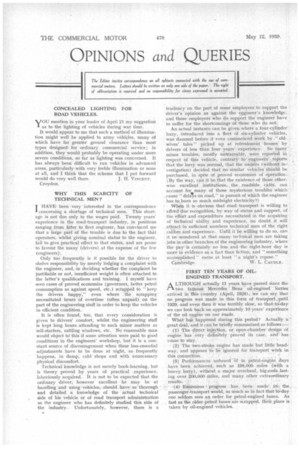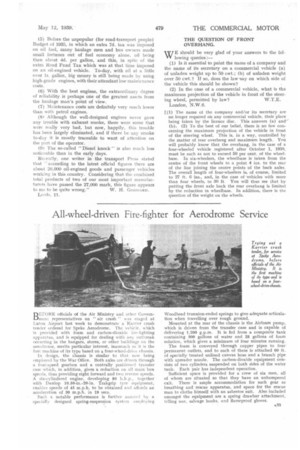OPINIONS and QUERIES
Page 42

Page 43

If you've noticed an error in this article please click here to report it so we can fix it.
The Editor invites correspondence on all sybjects connected with the use of commercial motors. Letters should be written on only one side of the paper. The right of abbreviation is reserved and no responsibility for views expressed is accepted.
CONCEALED LIGHTING FOR ROAD VEHICLES.
YOU mention in your leader of April 21 my suggestion as to the lighting of vehicles during war time. It would appear to me that such a method of illumination might well be applied to army vehicles, many of which have far greater ground clearance than most types designed for ordinary commercial service; in addition, they would probably be operating under more severe conditions, so far as lighting was concerned. It has always been difficult to run vehicles in advanced areas, particularly with very feeble illumination or none at all, and I think that the scheme that I put forward
would do very well there. J. H. VINCENT. Croydon.
WHY THIS SCARCITY OF TECHNICAL MEN?
I HAVE been very interested in the correspondence concerning a shortage of technical men. This shortage is not due only to the wages paid. Twenty years' experience in the road-transport industry, in positions ranging from fitter to fleet engineer, has convinced me that a large part of the trouble is due to the fact that operators, whilst giving nominal status to the engineer, fail to give practical effect to that status, and are prone to favour the many (drivers) at the expense of the few (engineers).
Only too frequently is it possible for the driver -to shelve responsibility by merely lodging a complaint,with the engineer, and, in deciding whether the complaint be justifiable or not, insufficient weight is often attached to the latter's qualifications and training. I myself. have seen cases of proved economies (governors, better petrol consumption as against speed, etc.) scrapped to "keep the drivers happy," even where the scrapping necessitated hours of overtime (often unpaid) on the part of the engineering staff in order to keep the vehicles in efficient condition.
It is often found, too, that every consideration is given to drivers' comfort, whilst the engineering staff is kept long hours attending to such minor matters as self-starters, rattling windows, etc. No reasonable man would object to' this if some attention were paid to good conditions in the engineers' workshop, but it is a constant source of discouragement when these less-essential adjustments have to be done at night, as frequently happens, in damp, cold shops and with unnecessary physical discomfort.
Technical knowledge is not merely book-learning, but is theory proved by years of practical experience, laboriously acquired. It is not to be expected that the ordinary driver, however excellent he may be at handling and using vehicles, should have as thorough and detailed a knowledge of the actual technical , side of his vehicle or of road transport administration as the engineer who has definitely studied this side of the industry. Unfortunately, however, there is a tendency on the part of some employers to support the driver's opinion as against the engineer's knowledge, and those employers who do support the engineer have to suffer for the shortcomings of those who do not.
An actual instance can be given where a four-cylinder lorry, introduced into a fleet of six-cylinder vehicles, was damned before it even commenced work by "
oldwives' tales " picked up at refreshment houses by drivers of less than four years' experience. So ,many minor troubles, mostly untraceable, were reported in respect Of this vehicle, contrary to engineers'.. reports that the lorry was normal, that the owners (without investigation) decided that no similar vehicles should be purchased, in spite of proved economies of operation. (By the way, can it be that the existence of those otherwise excellent institutions— the roadiide cafes', can account foromany of those mysterious troubles which . cause "delays on road," in pursuit of which the engineer has to burn so much midnight electricity?)
When it is obvious that road transport is willing to afford due recognition, by way of status and support, of the effort and expenditure necessitated in the acquiring of technical ability and experience, no doubt it will attract in sufficient numbers technical men of the right calibre and experience. Until it be willing to do so, can it be wondered at that many technical men are taking jobs in other branches of the engineering industry, where the pay is certainly no less and the eight-hour day is more in evidence as a fact than fiction, and "something accomplished" earns at least "a night's repose."
Cambridge. W. L. CAUDLE.
FIRST TEN YEARS OF OIL.. ENGINED TRANSPORT.
ALTHOUGH actually 11 years have passed since the two famous Mercedes Benz oil-engined lorries . arrived in this country (April, 1928), we can say that no progress was Made in this form of transport ..until 1929, and even then it was terribly slow, so that hi-day we can look back on approximately 10 years' experience of the oil engine on our roads.
What has happened during this period? Actually a great deal, and it can be briefly summarized as follows
(1) -The direct injection, or open-chamber design of engine has very definitely proved its case, andhas come to stay.
• (2) The two-stroke -engine has made but little headway, and appears to lie ignored for fransport wink in this connection.
(3) Performances unheard of in petrol-engine. days have been achieved, such as 198,000 miles -(with a heavy, lorry), without a major overhaul, big-,ends lasting over 200,000 Miles, and many other extraordinary
results. • .
(4) Enormous progress has been made , the passenger-transport world, so much so in fact that 'id-day one seldom sees an order for petrol-engined buses. As fast as the older petrol buses' arescrapped, their place is taken by oil-engined vehicles. (5) Before the unpopular (for road-transport people) Budget of 1935, in which an extra 7d. tax was imposed on oil fuel, many haulage men and bus owners made small fortunes out of fuel economy alone, oil being then about 4d. per gallon, and this, in spite of the extra Road Fund Tax which was at that time imposed on an oil-engined vehicle. To-day, with oil at a little over is. gallon, big money is still being made by using high-grade engines, with their attendant low mai nte nan ce costs.
(6) With the best engines, the extraordinary degree of reliability is perhaps one of the greatest assets from the haulage man's point of view, (7) Maintenance costs are definitely very much lower than with petrol engines.
(81 Although the well-designed engines never gave any trouble with exhaust smoke, there were some that were really very bad, but now, happily, this trouble has been largely eliminated, and if there be any smoke to-day it is mostly traceable to want of attention on the part of the operator.
(9) The so-called "Diesel knock" is also much less noticeable than in the early days.
Recently, one writer in the transport Press stated that " according to the latest official figures there are about 20,000 oil-engined goods and passenger vehicles working in this country. Considering that the combined total products of two of Our most important manufacturers have passed the 27,000 mark, this figure appears
to me to be quite wrong." W. H. Goonaan. Leeds, 11. THE QUESTION OF FRONT OVERHANG.
xyl E should be very glad of your answers to the folVV lowing queries:— (1) Is it essential to paint the name of a company and the name of its secretary on a commercial vehicle (a) of unladen weight up to 50 cwt.; (b) of unladen weight over 50 cwt.? If so, does the law say on which side of the vehicle this should be shown?
(2) In the case of a commercial vehicle, what is the maximum projection of the vehicle in front of the steer
ing wheel, permitted by law? W.T.E. London, N.W.6.
[(1) The name of the company and/or its secretary are no longer required on any commercial vehicle, their place being taken by the licence disc. This answers (a) and (b). (2) To the best of our belief, there is no law concerning the maximum projection of the vehicle in front of the steering wheel. This is, in a way, controlled by the matter of rear overhang and maximum length. You will probably know that the overhang, in the case of a four-wheeled vehicle registered after October 1, 1938, must be such as not to exceed 50 per cent. of the wheelbase. In six-wheelers, the wheelbase is taken from the centre of the front wheels to a point 4 ins, to the rear of the line joining the centre points of the back axles. The overall length of four-wheelers is, of course, limited to 27 ft. 6 ins., and, in the case of vehicles with more than four wheels, to 30 ft You will thus see that by putting the front axle back the rear overhang is limited by the reduction in wheelbase. In addition, there is the question of the weight on the wheels.














































































